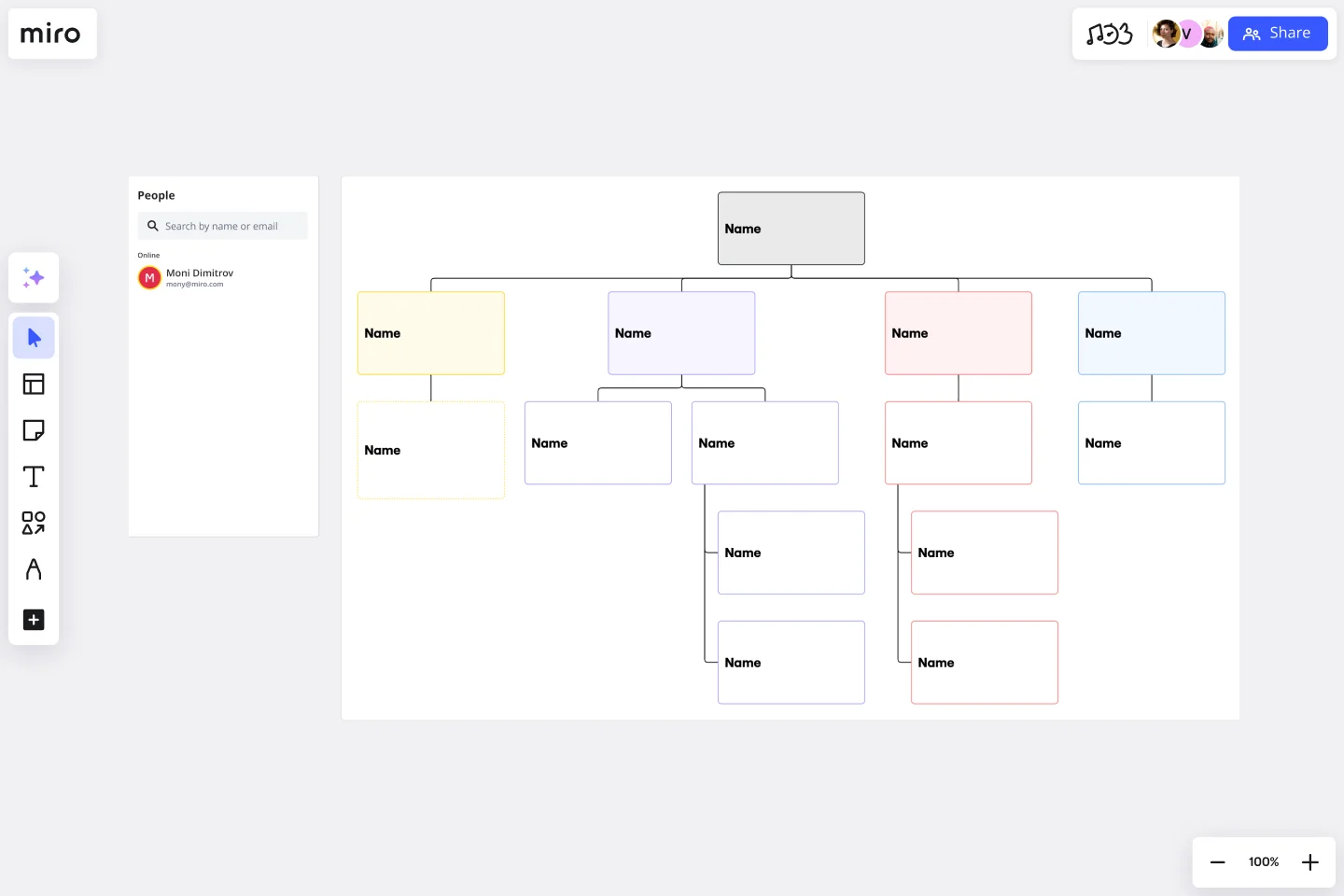Company Organizational Chart
Create a visual guide to the structure of your organization.
About the Company Organizational Chart template
A company organizational chart is a visual guide to how your organization is structured. It will generally reflect the reporting structure (who manages specific teams and people) and can be especially helpful for new employees to refer to as they familiarize themselves with your company.
Why should you use a company organizational chart?
In addition to showing the relations between employees at your company, you can also use a company organizational chart template to represent the structure of different departments or corporate functions inside your business.
When to use a company organizational chart template?
You can use your company organizational chart when planning employees’ career plans, managing HR resources, or any presentation you see fit.
How do you use the company organizational chart template in Miro?
Creating a company organizational chart is easy using Miro! Simply follow these easy steps to create an organizational chart that visually showcases your company structure:
Start with our pre-made company org chart template. Then, customize any elements you’d like, changing the sizes, shapes, and colors. For example, you may want to use colors or shapes to indicate people’s level of authority or department.
Write the names of the people inside your organization, as well as their roles and responsibilities. You can either just leave it in written form or add photos or other images to represent each person visually in your company organizational chart.
Invite your coworkers to collaborate in your company organizational chart template with you. Your company organizational chart can be a living document, and any changes you or your teammates make to the chart will be reflected in real-time.
If you are interested in learning all about organizational charts, and the various types and uses, you can read our comprehensive guide.
What are the four types of organizational structures?
The traditional four types of organizational structures. Functional: C-level is on the top of the structure, followed by senior management, management, etc. Divisional: where product lines and geography organize teams and people. Matrixed: people are organized in teams depending on the project/product they are working on Flat: where hierarchies are little to none and teams self-manage themselves. These are traditional company organization structures, but as we live in a more dynamic and decentralized work environment, those structures have been challenged and disrupted by new agile teams and businesses.
Where can I find a company organizational chart?
You can find a company organizational chart in our Templates Library or Miroverse.
Get started with this template right now.
Entity Relationship Diagram Template
Works best for:
Flowcharts, Strategic Planning, Diagrams
Sometimes the most important relationships in business are the internal ones—between the teams, entities, and actors within a system. An entity relationship diagram (ERD) is a structural diagram that will help you visualize and understand the many complex connections between different roles. When will an ERD come in handy? It’s a great tool to have for educating and onboarding new employees or members of a team, and our template makes it so easy to customize according to your unique needs.
Card Sorting Template
Works best for:
Desk Research, UX Design, Brainstorming
Card sorting is a brainstorming technique typically used by design teams but applicable to any brainstorm or team. The method is designed to facilitate more efficient and creative brainstorms. In a card sorting exercise, you and your team create groups out of content, objects, or ideas. You begin by labeling a deck of cards with information related to the topic of the brainstorm. Working as a group or individuals, you then sort the cards in a way that makes sense to you, then label each group with a short description. Card sorting allows you to form unexpected but meaningful connections between ideas.
Impact Mapping Template
Works best for:
Agile Methodology, Mapping, Agile Workflows
When you’re building products and shipping goods (oh, and everything in between) there’s nothing more important than staying organized and on-task. Impact mapping is a great way to do it. This trusty product planning technique creates a graphical representation of all your goals and the steps it’ll take to reach each one — so you can clearly communicate with your teammates, align on business objectives, and build better roadmaps. Our template will help you do impact mapping for any type of project planning.
Elevator Pitch Template
Works best for:
Leadership, Marketing
Come together as a team and create a powerful Elevator Pitch with Miro’s template. Move projects forward and get your product idea funded with a killer storyline.
Business Mindmap
Works best for:
Diagramming
The Business Mindmap template is a visual tool for brainstorming, organizing, and presenting business ideas and concepts. It provides a structured framework for capturing and connecting thoughts, insights, and action items. This template enables teams to explore business strategies, analyze market trends, and develop innovative solutions. By promoting creativity and collaboration, the Business Mindmap empowers teams to generate and communicate actionable business plans effectively.
Good, Bad, Ideas, Action, Kudos Retrospective
Works best for:
Retrospectives, Meetings, Agile Methodology
The Good, Bad, Ideas, Action, Kudos Retrospective template offers a structured approach to retrospectives by categorizing feedback into five key areas: good, bad, ideas, action items, and kudos (appreciations). It provides elements for team members to share their thoughts, suggestions, and acknowledgments. This template enables teams to reflect on past performance, generate actionable insights, and celebrate achievements. By promoting inclusivity and constructive feedback, the Good, Bad, Ideas, Action, Kudos Retrospective empowers teams to foster collaboration, drive continuous improvement, and strengthen team dynamics effectively.
